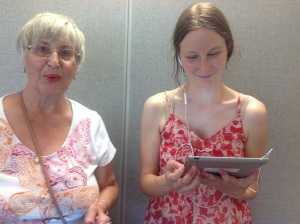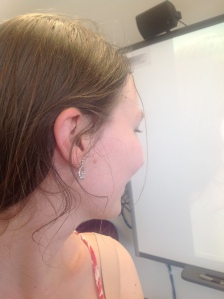
Our group met in the library of the central campus of Christ Church University, not to be confused with the University of Kent. Canterbury is a real university town and in summer tourists replace the students.
The atmosphere of the whole workshop was informal and very friendly. As a beginner I didn’t feel intimidated or embarrassed to ask questions and the more professional photographers shared their experiences with us. See my first post about the workshop for some of the participant’s websites.
IPads
Everyone who wanted got an IPad and we got a short introduction on the inbuilt camera and photos apps and how to use the IPad with Voice Over. Since I own an IPhone I found the tablet easy to use, but I think someone who isn’t familiar with IOS devices and technology in general might have needed a bit more time. On the other hand they are very user friendly and the ideal device for photography beginners. (See this previous post about smartphone photography.)
I enjoyed looking at the taken pictures on the bigger screen of the IPad. The quality of the display was much better than that of my PC monitor at home. On the other hand it was a bit cumbersome to carry around and I was afraid I would drop it. I think my IPhone 6 Plus is a good compromise. All the same IPads are definitely nice toys.
The History of Photography
After the lunch break Simon Hayhoe, the main organizer, gave a talk on the history of photography. I won’t attempt to repeat everything. His main point was that photography as we know it today wasn’t suddenly invented, it developed over time with different camera types. Here are some of the facts I found especially interesting:
The Chinese made the first pinhole cameras (or camera obscura) 2.500 years ago. Painters like Michelangelo still used them as drawing tools in the 16th century. They reflected their subject onto a surface and retraced it from there. In the 18th and 19th century cameras became more sophisticated thanks to scientific discoveries in chemistry, enabling photographers to take longer lasting pictures and eventually to produce negatives. The word photography – photo Greek for Light and graph for Greek drawing – is used since 1839. With the introduction of the first commercial cameras in the 19th century, studio photography became affordable to almost everyone. While previously only rich people could pay a painter to draw their family pictures, ordinary people too now had their pictures taken. Nevertheless, these pictures of people in their Sunday finery sitting or standing in neat rows were still rare enough to be treasured and to be passed on to the next generation.
Around 1900 the first role film was invented. Most of us still remember the last film roles with 36 pictures all of which had to be developed. My mum used to put them into photo albums with handwritten captions underneath them. Nowadays we take hundreds and hundreds of pictures without even thinking about it. Photo shop programmes offer a much wider range of opportunities to create photo albums, collages and slide shows. I definitely don’t want to go back, but I think it is important to remember from time to time that there is a history behind photography and cameras.
Selfies:
Our first task was to take pictures of each other, trying to convey a part of the model’s personality, which was a bit difficult for me because I met everyone for the first time that day. I attempted to make people look natural and not as if they were posing for the camera. Thus, I made them talk about something, hoping they would relax, but I found it hard to keep up a conversation while looking at the person through an IPad. That’s a skill one has to practice.

Finally, we looked at inspiring photos other blind photographers made and Simon encouraged us to take selfies. Although, I don’t like selfies particularly, it was fun to apply special effect filters to my face, until I was unrecognizable; in fact it is even hard to discover the outlines of a face in some of the pictures. I felt like a child in a mirror cabinet.
While taking selfies, I found another great advantage of the IPad for me: I can see my face in the front camera even when I hold it at an arms length away from me, whereas when using devices with smaller displays I often don’t get my whole face.
We attached my IPad to a projector, so that I could see what was in front of the camera projected on the wall. It was a strange sensation to see my face that close up in the middle of the room for everyone to see, but fascinating all the same. I tried to take pselfies from unusual perspectives. For this one I held the IPad behind me to take a picture of my profile.
A bit of sightseeing
After our first day’s work, we strolled out into the sunny afternoon to explore the city. Unfortunately, by the time we finished in the afternoons most sights and museums were about to close. We managed to visit St. Augustin’s Abbey, or the ruins that are left of it. It offers an audio guide, telling visitors about the various buildings and the history of the Abbey in general. The original Abbey was founded shortly after AD 597 by St. Augustine to mark the reintroduction of Christianity in South England.
There’ll be more about Canterbury’s ancient buildings in the next post about our day at the famous Canterbury Cathedral.
Tina

